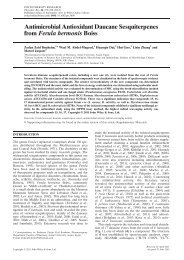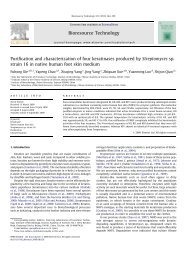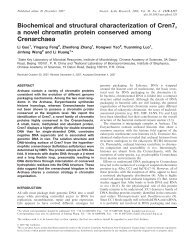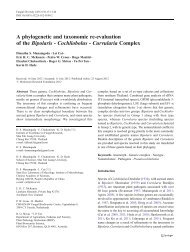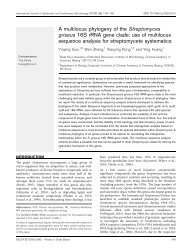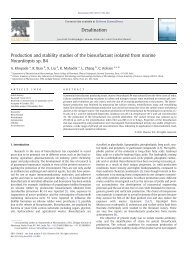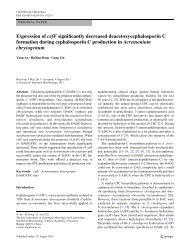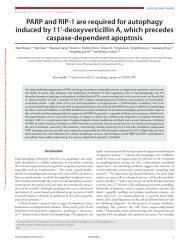Cdc42 regulates microtubule-dependent Golgi positi... - ResearchGate
Cdc42 regulates microtubule-dependent Golgi positi... - ResearchGate
Cdc42 regulates microtubule-dependent Golgi positi... - ResearchGate
You also want an ePaper? Increase the reach of your titles
YUMPU automatically turns print PDFs into web optimized ePapers that Google loves.
Hehnly et al.<br />
by dissociating <strong>Cdc42</strong> from coatomer using the γ-<br />
COP-binding C-terminal p23 peptide containing residues<br />
199–212 (5,21,22) and assaying the motility of the<br />
exogenous <strong>Golgi</strong> membranes in the permeabilized cells.<br />
We observed that the fraction of motile <strong>Golgi</strong>-membrane<br />
particles, the distances traveled, and the particle velocities<br />
were each increased when the membranes were<br />
incubated with the p23 peptide (Figures 6A,B, S4A,B,<br />
Movies S1 and S2); in the absence of the peptide<br />
approximately 30% of the particles moved during a<br />
5-second observation, whereas in its presence about 60%<br />
were motile. A control peptide had no effect on membrane<br />
motility (Figure S4B).<br />
Although effects of the p23 peptide have been previously<br />
characterized to result from dissociation of the coatomer/<br />
<strong>Cdc42</strong> complex (5,22), it is still possible that the peptide<br />
stimulates <strong>Golgi</strong> motility through a <strong>Cdc42</strong>-in<strong>dependent</strong><br />
mechanism. Hence, we have also used the recombinant<br />
<strong>Cdc42</strong>-binding (p21-binding domain, PBD) fragment<br />
from PAK1 as an alternative method to inhibit <strong>Cdc42</strong><br />
activity (31). Addition of recombinant PBD increased the<br />
fraction of motile <strong>Golgi</strong> particles (Figures 6C and S4C),<br />
<strong>Golgi</strong> particle velocity (Figure S4D) and travel distances<br />
(Figure S4E). The similar results obtained with the p23<br />
peptide and the recombinant PBD are fully consistent<br />
with a role for <strong>Cdc42</strong> in regulating the <strong>Golgi</strong> motility.<br />
Our previous study demonstrated that ARF1 not only<br />
influences <strong>Cdc42</strong> signaling at the <strong>Golgi</strong> apparatus, but that<br />
ARF1 activation was necessary for dynein recruitment to<br />
<strong>Golgi</strong> membranes (5). Hence, we examined the effects of<br />
ARF inhibition on <strong>Golgi</strong> motility. We found that brefeldin<br />
A completely blocked the ability of p23 to stimulate motility,<br />
indicating that ARF activation is required (Figure S5).<br />
Low levels of the actin toxin cytochalasin D were found<br />
previously to stimulate dynein recruitment (5). This is consistent<br />
with the model that ARF1- and <strong>Cdc42</strong>-regulated<br />
actin dynamics influence <strong>microtubule</strong>-mediated motility.<br />
We find that cytochalasin D has a similar stimulatory<br />
effect on <strong>Golgi</strong>-membrane motility (Figure 6A,D).<br />
The ability to stimulate <strong>Golgi</strong> motility with the coatomerbinding<br />
p23 peptide, PBD and cytochalasin D supports<br />
the model that coatomer-bound <strong>Cdc42</strong> <strong>regulates</strong> dynein<strong>dependent</strong><br />
motility of <strong>Golgi</strong> membranes. Furthermore,<br />
we calculated the average velocity of <strong>Golgi</strong> particle<br />
movement in the presence of the p23 peptide to be<br />
664 ± 35 nm/second (n = 30). This velocity is consistent<br />
with previous measurements for dynein-based motility<br />
in vitro (32). We used Western blot analysis of reisolated<br />
<strong>Golgi</strong> membranes to test directly whether p23 peptide<br />
addition affects the recruitment of dynein to <strong>Golgi</strong><br />
membranes under the reaction conditions used for the<br />
motility assay. Consistent with our previous report (5), the<br />
peptide inhibited <strong>Cdc42</strong> binding while stimulating dynein<br />
recruitment (Figure 6E). Finally, we used an inhibitory<br />
dynein antibody to determine if p23-peptide-stimulated<br />
motility was dynein <strong>dependent</strong>. Importantly, the peptide<br />
no longer stimulated motility in the presence of the<br />
inhibitory dynein antibody (Figure 6F). A control antibody<br />
against kinesin did not inhibit the motility (not shown).<br />
The effects of p23 peptide on <strong>Golgi</strong> motility in vitro<br />
are consistent with the effects of GFP-p23(199–212)<br />
expression in intact cells and together support a<br />
model wherein dissociation or inactivation of coatomerbound<br />
<strong>Cdc42</strong> acts in a permissive manner to stimulate<br />
dynein recruitment and dynein-based motility of <strong>Golgi</strong><br />
membranes.<br />
Discussion<br />
We found previously that activation of <strong>Cdc42</strong>, a Rhofamily<br />
GTP-binding protein, inhibits the recruitment of<br />
dynein motors to membranes and that <strong>Cdc42</strong> influences<br />
intracellular dynein-<strong>dependent</strong> trafficking (5,19). We have<br />
now further characterized the contribution of <strong>Cdc42</strong><br />
signaling to dynein-<strong>dependent</strong> <strong>Golgi</strong> <strong>positi</strong>oning at the<br />
centrosome. We find that both constitutive and acute<br />
disruption of the <strong>Cdc42</strong> GTPase cycle affects <strong>Golgi</strong><br />
re<strong>positi</strong>oning after nocodazole treatment and washout.<br />
Notably, we find that expression of GFP-p23(199–212),<br />
which contains a dibasic motif expected to dissociate<br />
<strong>Cdc42</strong> from the <strong>Golgi</strong>-coat protein coatomer, is able<br />
to increase the rate of <strong>Golgi</strong> re<strong>positi</strong>oning at the<br />
centrosome. By contrast, activating <strong>Cdc42</strong> using RNAibased<br />
knockdown of ARHGAP21 expression decreased<br />
the ability of <strong>Golgi</strong> membranes to cluster at the<br />
centrosome. Taken together, our results lead to the<br />
hypothesis that <strong>Cdc42</strong> acts in an inhibitory manner to<br />
regulate dynein-based motility of intracellular membranes.<br />
We have tested this hypothesis in the second half of this<br />
study by measuring <strong>Golgi</strong>-membrane capture and motility<br />
in permeabilized cells. Although we have previously<br />
shown the effects of <strong>Cdc42</strong> on dynein recruitment<br />
and intracellular trafficking (5,19), heretofore, we have<br />
not shown that <strong>Cdc42</strong> can directly affect membrane<br />
motility. We now show that treatments expected to<br />
dissociate <strong>Cdc42</strong> and stimulate dynein recruitment to<br />
<strong>Golgi</strong> membranes greatly increase the fraction of <strong>Golgi</strong><br />
membranes undergoing dynein-mediated transport in<br />
permeabilized cells.<br />
<strong>Cdc42</strong> functions downstream of ARF1<br />
and ARHGAP21 to regulate <strong>Golgi</strong> motility<br />
<strong>Cdc42</strong> function at the <strong>Golgi</strong> apparatus is connected to<br />
ARF1 in at least two ways. First, <strong>Cdc42</strong> localizes to the<br />
<strong>Golgi</strong> complex through a cargo-protein-sensitive binding<br />
interaction with the ARF1-regulated vesicle-coat protein,<br />
coatomer (5,21,22). Second, ARF1 binds to the <strong>Golgi</strong>localized<br />
<strong>Cdc42</strong>-specific GAP ARHGAP21 (23,24). We<br />
propose that ARF1 helps direct the localization of both<br />
ARHGAP21 and <strong>Cdc42</strong> in order to regulate the activation<br />
state of <strong>Cdc42</strong> on <strong>Golgi</strong> membranes.<br />
Our previous work suggests that the coatomer/<strong>Cdc42</strong><br />
complex <strong>regulates</strong> dynein recruitment through a manner<br />
1074 Traffic 2010; 11: 1067–1078






